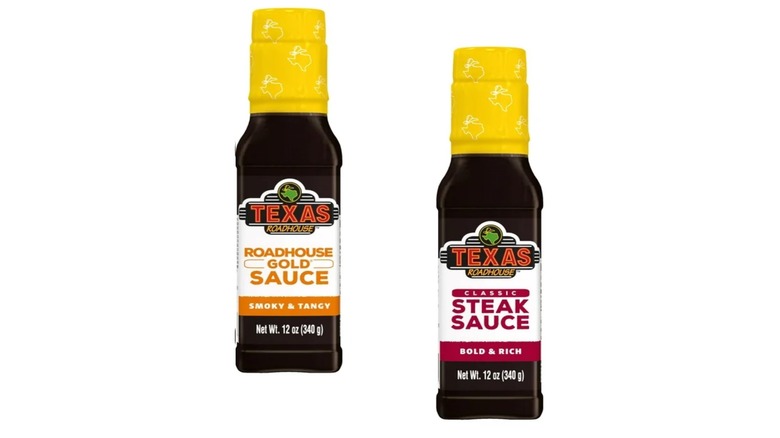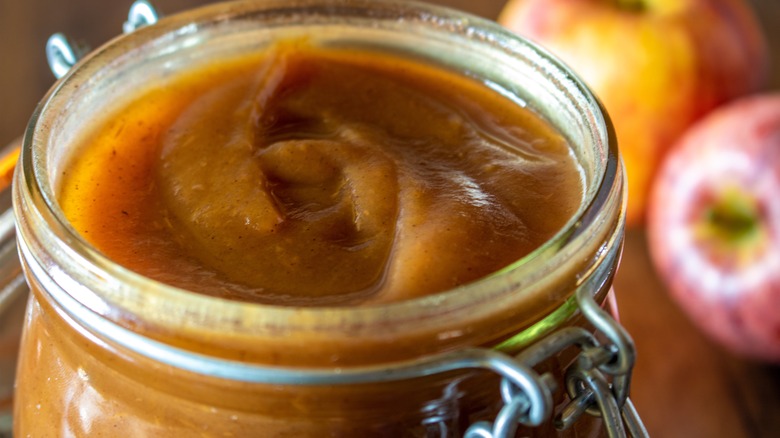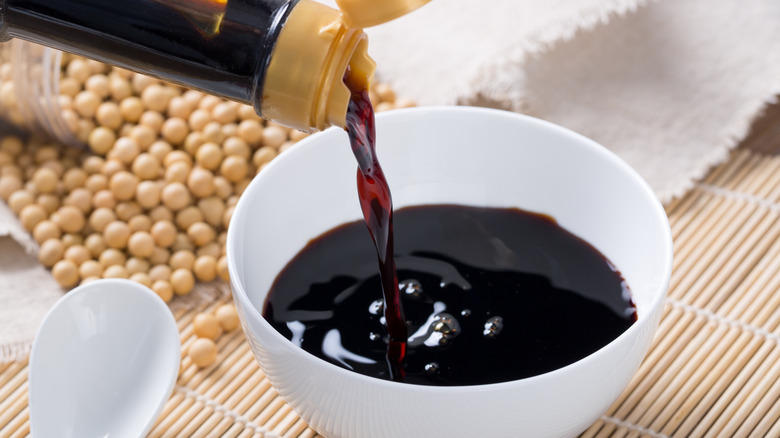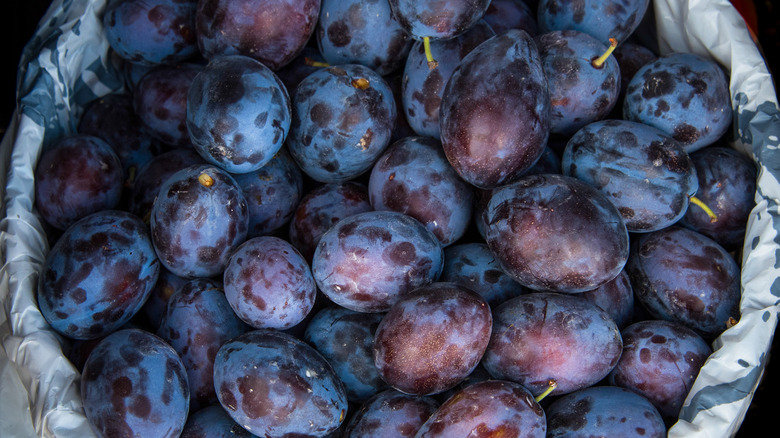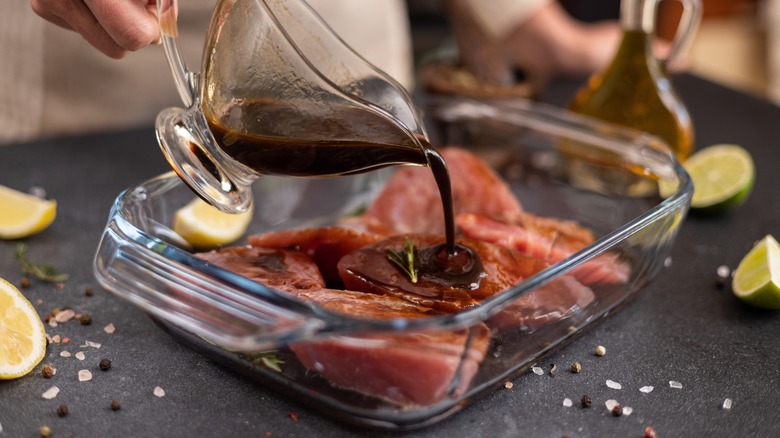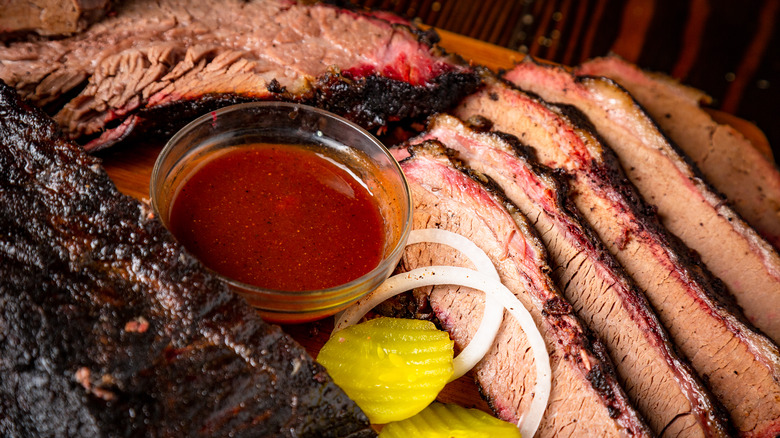What Really Makes Texas Roadhouse's Steak Sauce So Delicious
We may receive a commission on purchases made from links.
There's no shortage of steak sauces to choose from on grocery store shelves. Yet most of them don't quite give you the same experience you'd get when dining at your favorite steakhouse. For many, that favorite steakhouse is Texas Roadhouse, a chain restaurant that prides itself on hand-cut steaks and a menu full of entirely house-made dishes. Founded in 1993, the company claims that everything is made in-house in each of its 620 locations, including such seemingly small details as bacon bits, salad croutons, and salad dressings.
While the promise of a meal made from scratch is plenty attractive on its own, Texas Roadhouse has something no other restaurant offers — its signature steak sauce. The steakhouse chain has been turning diners into loyal fans for decades with its one-of-a-kind sauce, which up until now has been primarily only available in its restaurants. But a recent partnership with the T. Marzetti Company (which also produces sauces for major restaurant brands like Chick-fil-A, Buffalo Wild Wings, Arby's, Olive Garden, and Subway) has brought Texas Roadhouse's signature steak sauce to grocery store shelves everywhere. Now, fans of the restaurant's sauce will finally be able to bring home the steak sauce they enjoy in restaurants, along with a brand new Texas Roadhouse steak sauce that has been created just for the retail market. But what's so special about Texas Roadhouse's signature sauce? I took at look at what sets this particular steak sauce apart from the competition, and here's what I found.
Two new sauces, one original flavor
The retail launch of Texas Roadhouse-branded steak sauces in grocery stores means that both newcomers and long-time fans of the restaurant's signature sauce will be able to enjoy it as often as they like. Prior to the most recent release, Texas Roadhouse's "Steak Sauce," packaged in a nondescript black bottle, could be found by enthusiasts online and in restaurants. However, it wasn't as widely available as it is now. Both the original restaurant-style steak sauce and a new steak sauce are part of the retail lineup, but there may be some confusion as to which sauce is the one fans of the restaurant already know and love.
The Texas Roadhouse "Classic" Steak Sauce might seem like the obvious choice if you're looking for what you'd find in the restaurant — but it isn't. In fact, it's an entirely new sauce that is closer to a classic A.1. steak sauce (or perhaps a copycat you made at home). In fact, the new Classic Steak Sauce currently isn't served in restaurants at all and can only be found in grocery stores.
Instead, fans of the restaurant's original steak sauce should look for the newly branded Roadhouse Gold Sauce. Connoisseurs will be able to immediately tell the difference between the two by taste. But, unless you are already familiar with the special ingredients used in the original sauce, it could be hard to tell which one to choose simply by looking at the bottle. What sets the Texas Roadhouse Gold Sauce apart from the competition?
The main ingredient isn't in your typical steak sauces
If you were to pick up a typical bottle of steak sauce, be it A.1.'s Original Steak Sauce or Peter Luger's Steak House Sauce, you'll notice that the main ingredient is tomatoes. Sometimes, it's tomato puree, crushed tomatoes, or some other variation of tomatoes. Either way, it's safe to assume that it's tomato-based. Not in Texas Roadhouse's famous steak sauce, though. Whether it was by accident or to intentionally set this sauce apart from the crowd, the Roadhouse Gold Sauce is made with apple butter instead of tomatoes.
According to the ingredients list, the apple butter itself is made with the same ingredients you'd find in traditional apple butter, including brown sugar and spices. While it doesn't say precisely what kinds of apples are used, it makes sense that the slow-roasted apples would impart similar sweet and acidic notes to the sauce as tomatoes often do, though with a slightly less savory bent. Otherwise, it includes similar variations of water, sugar, vinegar, and salt that you'll find listed on other bottles of steak sauce.
That said, tomatoes do make an appearance in the Roadhouse Gold Sauce. Further down the ingredients list, you'll notice a mention of tomato paste (which is just concentrated tomatoes). It was presumably added to the mix to incorporate some of that familiar steak sauce flavor, as well as to provide a little bit of savory depth to balance the sweetness of the more dominant apple butter.
Soy sauce gives it a touch of umami
There's no one way to make a steak sauce, and many such sauces glean flavor profiles from one of its next-closest kin: Worcestershire sauce. It's widely believed that Worcestershire sauce was invented around 1835, roughly a decade after steak sauce made its possible first appearance after Britain's King George IV reportedly asked his private chef to craft it. While today Worcestershire sauce is widely known and praised for its signature umami flavor (that's thanks to the potentially surprising inclusion of anchovies), it's still not something that you'll always find in a bottle of steak sauce. Instead, the Texas Roadhouse Gold Sauce instead incorporates another similar addition: soy sauce.
The obvious benefit of using soy sauce instead of anchovies is that the steak sauce will appeal to those who are allergic or are simply averse to a stronger fish-based mixture. Yet, thanks to its deep character and many flavor notes, it will appeal to practically anyone who wants a more complex sauce. The slightly bitter, salty, umami flavor of soy sauce doesn't just add complexity to the steak sauce. It also helps to marry some of the stronger sweet and sour flavors in the Texas Roadhouse version for a smoother overall taste. Additionally, for those who enjoy the sort of soy-marinated beef dishes that are popular in many Asian food cultures, that touch of soy sauce in the Texas Roadhouse Gold Sauce will be all the more welcome.
It swaps tangy orange for bittersweet prune juice
Some variation of orange is commonly found in many different sorts of steak sauces. This can take the form of orange juice, orange juice concentrate, crushed orange puree, or even aromatic orange zest or orange peels. Given how well sweet, acidic orange pairs with beef in many recipes, it's not an unexpected or unwelcome addition to a steak sauce. But once again, Texas Roadhouse's signature steak sauce switches things up by replacing the traditional orange juice with another potentially surprising swap: prune juice.
Don't dismiss it out of hand. Much like orange juice, prune juice is sweet and tangy, although its tartness can be a little more biting than many other, more common fruits found in steak sauces. Looking at the arrangement of ingredients in the Texas Roadhouse sauces, I suspect that the inclusion of prune juice instead of orange connects to the use of slightly sweeter apple butter. Since the sauce is already sweeter, choosing a juice with a more aggressive bittersweet bite is a logical way to achieve balance.
Much like orange, prune is also a flavor that pairs incredibly well with tamarind — an ingredient commonly included in Indian cuisine, as well as steak sauces and Worcestershire sauces. Tamarind is a fruit that once again harnesses both sweet and tangy flavors, pairing well with many savory dishes thanks to its slightly earthy and caramel undertones. The Texas Roadhouse Gold Sauce includes tamarind extract to round out the sauce's flavor profile.
You probably didn't realize there were raisins in your steak sauce
If you've never taken a good, hard look at the ingredients list on a bottle of steak sauce, then you might not have noticed that there are raisins in your steak sauce. Sorry, raisin haters, but there is a good reason (or two) for the inclusion of this sometimes divisive dried fruit in the mix. And it's not just the Texas Roadhouse steak sauces that do this. In fact, nearly every major steak sauce producer makes something that includes raisins or raisin paste. That's because raisins add a boost of natural sweetness and a deeper, more subdued fruit flavor compared to other potential ingredients. Raisin paste can also help to thicken the sauce, hopefully meaning that you don't have a surprise rush of juice splatter across your expensive steak (and your shirt).
It's also possible that raisins were first added to steak sauce for a more utilitarian purpose. Raisin paste, which is today commonly known to be rich in antioxidants, was once used to help prolong the shelf life of meats in the days before modern refrigeration was available. It appears to have been especially popular in the 19th century. Its usefulness as a preservative was two-fold, as it not only helped to slow down decay, but also potentially masked the flavor of meats that had already begun to turn. While refrigeration dramatically changed the way we store and preserve meats, steak sauces have generally remained the same over the last 200 years, raisins and all.
An unconventional smoky BBQ flavor
While many popular steak sauces take their flavor cues from Worcestershire sauce, Texas Roadhouse's famous restaurant sauce reaches a little further into the world of BBQ for inspiration. Given that Texas Roadhouse is inspired by all things Texan, a little bit of BBQ is a fitting choice. Even then, perhaps the most unconventional part of this steak sauce is its smoky flavor, which isn't subtle. A few drops of Roadhouse Gold Sauce can transform the flavor of a steak from one that seems like it was cooked on a flat-top restaurant grill into a backyard barbecue entrée.
The signature smokiness isn't necessarily the same sort of rich smoky flavor you'd actually get from smoking steaks over hickory or mesquite. Instead, you'll detect the kind of smokiness you'd expect from grilling in the backyard over a coal-fired grill with plenty of smoke and maybe a flare-up or two.
For those who are cooking their steak indoors, this steak sauce adds a touch of the outdoors without requiring you to brave the elements or spend time preheating and scraping down a grill. The smoky and tangy flavor might not appeal to everyone, but those who do enjoy it will likely love the departure from what they may otherwise find in an ordinary bottle of steak sauce.
A steak sauce made for more than just steaks
Even among steak lovers, it's unlikely that you'll be cooking steak dinners often enough to blow through an entire bottle of steak sauce in a timely manner, at least not if you're solely focusing on steak all by itself. But there's no reason to fear, as a good steak sauce can also be used to season more than just steaks. Luckily, the Texas Roadhouse Gold Sauce is a potential pro at helping you to do just that. Reviewers have mentioned using it on everything from hamburgers and chicken, to pork chops and sausages, as well as vegetables, noting how well the sauce pairs with all manner of different foods.
But the trick of seasoning meats other than steaks with a dose of steak sauce isn't exactly new. Even A.1. is labeled "Original Sauce" in a marketing move that's intended to help consumer focus less on using it for steak and make A.1. more marketable as a versatile component meant to be used on a variety of meats and vegetables. What the Roadhouse Gold Sauce offers is the same kind of adaptable form, with a slightly different flavor profile than what you'd find with a classic steak sauce. After all, it's nice to have options.
It makes a great addition to a sauce or marinade
Not only does this particular steak sauce deviate from other, more typical steak sauces in the flavor department, but it can also be used as a marinade or supplement to other sauces. As a marinade, it plays several roles. First, the acids and salts in the sauce help to tenderize the outer surface of your proteins before cooking, which can be especially helpful for tougher cuts of steak. Additionally, the sauce helps to develop your steak's natural taste and imparts additional complimentary flavors to your meat while it marinates. Once cooked with this sauce, you'll be able to taste notes of apple butter, soy sauce, and smokiness that are more unified with the flavor of the meat than if you were only to use the sauce as a post-cooking dressing.
If the smoky and tangy flavors of the Roadhouse Gold Sauce are especially appealing to you, considering adding it to other sauces to boost those flavors, including mayonnaise, butter, or olive oil-based mixtures. A few drops of Roadhouse Gold Sauce mixed into a mushroom pan sauce just before serving might just be the thing your steak has been missing this whole time.
A Texas Roadhouse steak sauce for every taste
The truth is that not everyone will fall in love with the unique flavors Texas Roadhouse Gold Sauce brings to the table. Even in Texas Roadhouse restaurants, diners typically have the option to use A.1. sauce instead of the chain's exclusive mix. But for those dining at home, Texas Roadhouse's new Classic Steak Sauce more closely resembles what you'll find in a more traditional bottle of steak sauce. It's made with the same familiar tomato and vinegar base and includes both raisin paste and tamarind for additional complexity. The Texas Roadhouse Classic Steak Sauce skips the umami notes of fish and soy sauce, keeping things simple with a more limited list of ingredients than the Gold Sauce.
For those who want the best of both worlds, the Gold Sauce could be used as a marinade on your favorite steaks, while the Classic Steak Sauce is deployed as a dressing once the steak has been cooked. Dry-aged or smoked meats don't necessarily require as much additional seasoning to amp up their flavors, but fresher meats such as chicken and pork can almost always use a boost. The Texas Roadhouse Gold Sauce manages to be both familiar and just different enough to excite steak sauce lovers everywhere, and can easily be one of the more versatile sauces in your grilling repertoire.
